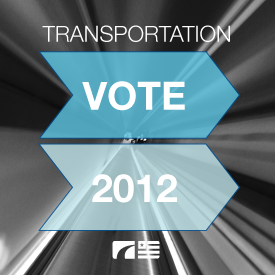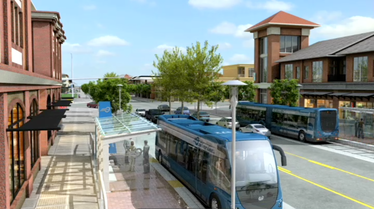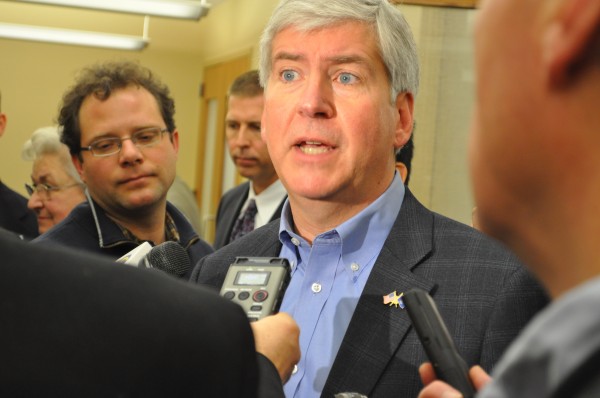
From state to town, Michigan takes strong steps toward a better transportation future
One place illustrating the national positive voting trends for transportation is Michigan, where citizens voted to raise taxes for transportation investments in cities and counties across the state, at least one anti-transit elected official was ousted, a Republican governor led the charge for regional transit investment in the state’s biggest metro and when given a chance to bail in the name of “cost savings,” local voters doubled down on their existing transit system.
 There were a lot of eyes on Michigan during Transportation Vote 2012, in part because of the sheer number of transportation measures being decided there: over 30 different ballot questions in 2012 alone, according to the Center for Transportation Excellence.
There were a lot of eyes on Michigan during Transportation Vote 2012, in part because of the sheer number of transportation measures being decided there: over 30 different ballot questions in 2012 alone, according to the Center for Transportation Excellence.
Though there were dozens of worthwhile transportation ballot measures passed this year, Eaton County, Kalamazoo County, Muskegon City, and Ogemaw County all either renewed or passed new substantial tax millages to support public transportation specifically.
That’s no fluke, as Tim Fischer of the Michigan Environmental Council told us. Fischer, the Deputy Policy Director for MEC and part of the Transportation for Michigan coalition echoed a familiar refrain about the success of transit related ballot measures.
“I think the real message is that voters will support transit almost every time when they know where their money is going and what it will be used for,” he said.
Along those lines, a handful of cities around the country were offered a choice to secede from existing transit systems and decide to send that money elsewhere — a phenomenon explained in more depth by Angie Schmitt at Streetsblog Capitol Hill a few weeks ago — including one vote in Walker County, Michigan, a city in the western suburbs of Grand Rapids. In a show of support for their existing system, voters in Walker rejected that attempt by a huge margin (73 percent opposed), “because residents see real value in their local transit systems even though they might not ever use them,” Fischer added.
“Road millages, by comparison, don’t always fare so well and have been rejected more often than passed in recent years. People perceive that they already pay for roads through the gas tax and are less inclined to pay for roads through millages.”
 (That wasn’t the only good news in Grand Rapids, which also recently received $20 million in federal funds to build a BRT line.)
(That wasn’t the only good news in Grand Rapids, which also recently received $20 million in federal funds to build a BRT line.)
In a more recent development, just last week, the Michigan legislature passed landmark legislation finally creating a regional transit authority in Detroit, something that transit advocates and Detroit leaders have been trying to do for decades.
They were no doubt urged along by USDOT Secretary Ray LaHood, who told Michigan leaders they wouldn’t receive federal money for the Detroit Woodward light rail line without a regional authority to receive and manage the money.
“The RTA passage will trigger USDOT to release $25 million in promised federal funds which will add to about $80 million in private money,” Fischer said. “In addition, a component of that legislation is the development of about 100 miles of rapid bus transit (‘BRT light’).”
The coalition that helped the RTA legislation along to victory was a broad one.
MOSES (Metropolitan Organizing Strategy Enables Strength), which does faith-based organizing within over 40 congregations in southeast Michigan, was a key part of the successful coalition. MOSES did much of the legwork to push the bill through, holding scores of meetings with legislators to affirm to them the importance of investing in public transportation (pdf), and explaining how the lack of this regional authority was a significant roadblock to doing that.
Michael Tasse with MOSES said that their leaders and members had been having meetings with legislators for over two years on the regional transit bill.
“We pushed the governor to support it,” Tasse said. “We helped persuade legislators who were on the fence or who might not have initially supported it by helping them to understand the bill. A big part of what we spent a year doing is educating them on the bill and pushing them to read through it and understand it. We made scores of visits in district, and we went to Lansing more than ten times.”
MOSES is celebrating the passage of the bill as 2012 comes to a close. “This is important because it’s about transportation — not just rail lines to Chicago, but the bus lines that connect people across town and the factories across town and the suburbs,” he explained. “Connecting people to those jobs is how we’re going to build strong families and communities in Southeast Michigan. If people can’t get around, they’re stuck, and that creates a gap between the few and the many.”
But the wins go beyond just local or regional transit in Michigan. Passenger rail statewide has had a significant boost in the last year, certainly helped along by the leadership and straight-up boosterism of the Republican Governor Rick Snyder.

Michigan Governor Rick Snyder talks to the media at an event sponsored by the Michigan Municipal League.
Michigan has received about $500 million for the Chicago-Detroit/Pontiac passenger rail route, including funds to purchase about 130 miles of track from NS, adding to the 100 miles already owned by Amtrak. 234 miles of the 300 mile Chicago-Detroit route are now under public ownership. Trains are already running at speeds of 110 mph on some of this stretch, and they’ll run that fast for longer stretches once more track is upgraded next construction season.
Incidentally, this line from Detroit to Pontiac runs right through the town of Troy, where a mayor who refused a federal grant to build a new train station there was ousted by recall in November and removed from office.
All of these stories of Michigan communities and the state seizing control of their futures and declaring the importance of transportation at the ballot box are encouraging, but they still can’t go it alone — they need the feds to step up and support these kinds of communities leading the way.
“The rail projects wouldn’t exist without it [federal support], nor would the Grand Rapids BRT line,” Tim Fischer told us. “The locals must do their part, but federal money is necessary to turn the projects into reality.”
Michigan boosters like Fischer see the positive trend continuing.
“I am optimistic for Michigan’s future. Our passenger rail programs and transit systems have come a long way in just a few short years. Also, communities across the state have great interest in complete streets — over 80 have adopted complete streets policies or resolutions since we established our complete streets law in 2010.”
“Things are coming together at long last,” Fischer said.



